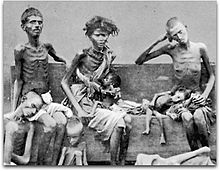
Back المجاعة في الهند Arabic ভারতে দুর্ভিক্ষ Bengali/Bangla רעב בהודו HE भारत में अकाल Hindi Carestie in India Italian 인도의 기근 Korean Голод в Индии Russian இந்தியாவில் பஞ்சம் Tamil

Famine had been a recurrent feature of life in the South Asian subcontinent countries of India and Bangladesh, most notoriously under British rule. Famines in India resulted in millions of deaths over the course of the 18th, 19th, and early 20th centuries. Famines in British India were severe enough to have a substantial impact on the long-term population growth of the country in the 19th and early 20th centuries.
Indian agriculture is heavily dependent on climate: a favorable southwest summer monsoon is critical in securing water for irrigating crops.[1] Droughts, combined with policy failures, have periodically led to major Indian famines, including the Bengal famine of 1770, the Chalisa famine, the Doji bara famine, the Great Famine of 1876–1878, and the Bengal famine of 1943.[2][3] Some commentators have identified British government inaction as a contributing factor to the severity of famines during the time India was under British rule.[4][page needed] Famine largely ended by the start of the 20th century with the 1943 Bengal famine being an exception related to complications during World War II. In India, traditionally, agricultural laborers and rural artisans have been the primary victims of famines. In the worst famines, cultivators have also been susceptible.[5]
Railroads built for the commercial goal of exporting food grains and other agricultural commodities only served to exacerbate economic conditions in times of famine.[6][7] However, by the 20th century, the extension of the railroad by the British helped put an end to the massive famines in times of peace. They allowed the British to expedite faster sharing of food out to the most vulnerable.[8]
The last major famine to affect areas within the modern Republic of India was the Bengal famine of 1943. While the areas formerly part of British India, the Bangladesh famine of 1974 was the last major famine.[9]
- ^ Swain, Patel & Nandi 2017.
- ^ Nash 2003, pp. 22–23.
- ^ Collier & Webb 2002, p. 67.
- ^ Davis 2001.
- ^ Drèze 1991, p. 17.
- ^ Sourabh & Myllyntaus 2015.
- ^ "Infrastructure and railroads". Environment & society. 28 July 2015. Archived from the original on 10 June 2017.
- ^ Burgess & Donaldson 2012, p. 4.
- ^ Alamgir 1980, p. xviii.
© MMXXIII Rich X Search. We shall prevail. All rights reserved. Rich X Search